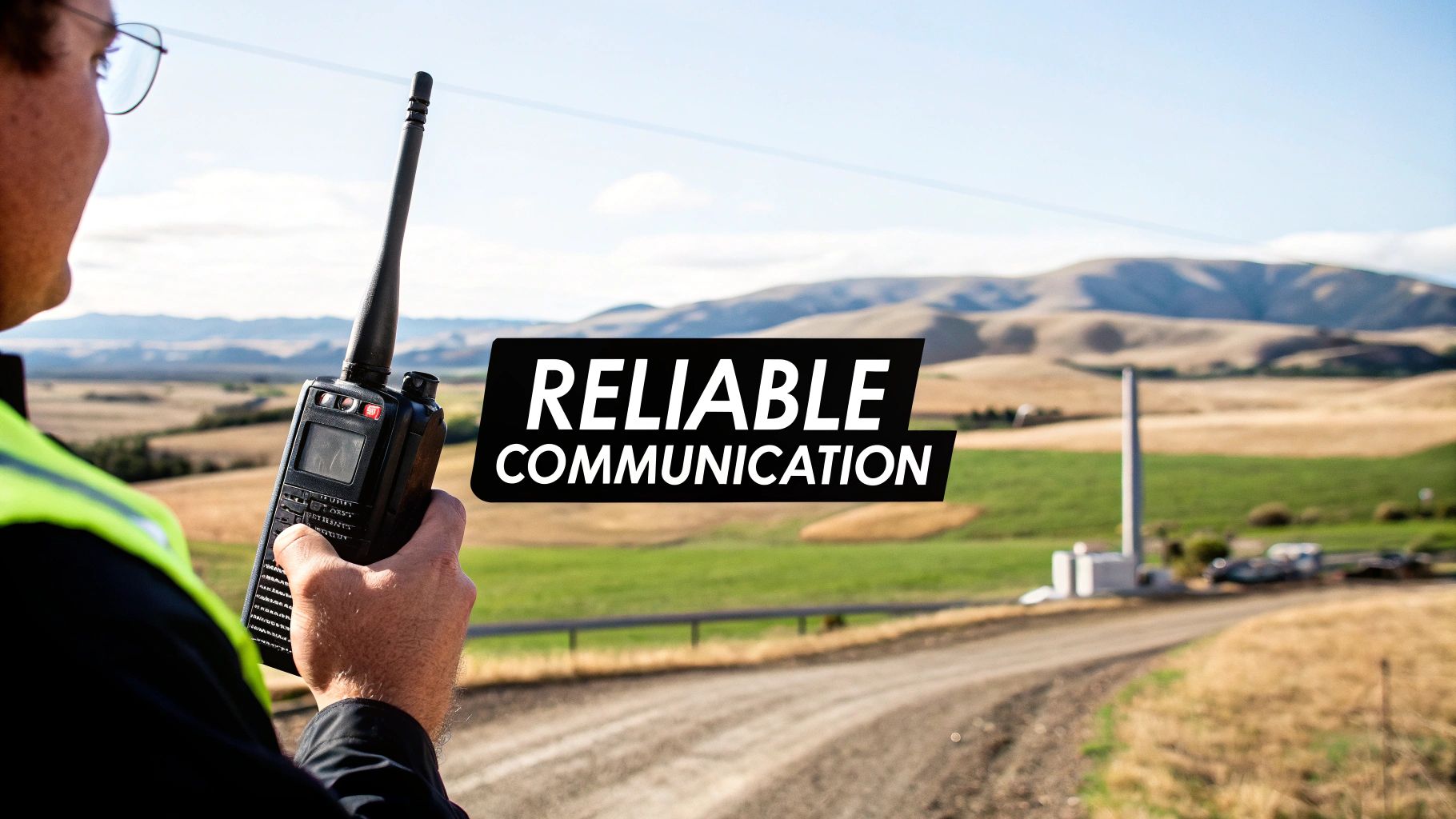VHF Marine Radio NZ: A Guide to Legal and Effective Communication on the Water
For anyone heading out on New Zealand's beautiful but often unpredictable waters, a VHF marine radio is an essential, non-negotiable legal communication device. It's your primary lifeline when mobile phone signals disappear, which they often do just offshore. A good VHF connects you directly to help, provides critical weather updates, and allows communication with other vessels nearby. It's much more than just another gadget; it's a critical piece of safety equipment regulated for use in New Zealand.
Your Essential Lifeline on New Zealand Waters
Picture this: you're caught in a sudden squall off the Coromandel Peninsula, or maybe your engine gives up the ghost somewhere in the Marlborough Sounds. You grab your phone, but all you see is "No Service." This is the exact moment a VHF marine radio goes from being a nice-to-have to your most critical asset.
Think of it as a dedicated emergency hotline for the sea. It’s a communication solution designed from the ground up for the tough marine environment, and it works reliably where consumer electronics simply won't. Relying solely on a mobile phone when you're offshore is a gamble you don't want to take.
The Core Functions of a VHF Marine Radio
Knowing what your radio can legally do is the first step to using it properly. It has a few core jobs, each designed to keep things safe and orderly on the airwaves.
- Distress Calls (Mayday): This is for when things have gone seriously wrong. We're talking grave and imminent danger, like a fire, sinking, or a life-threatening medical situation. A Mayday call on Channel 16 gets an immediate response from anyone who hears it, including Maritime Radio and all vessels in the area.
- Urgent Communications (Pan Pan): This is for situations that are serious but not immediately life-threatening. Maybe you've lost a propeller, had a non-critical engine failure, or someone needs medical attention but isn't in immediate danger.
- Safety Announcements (Sécurité): These are broadcasts about navigational hazards or important weather warnings. You might hear a Sécurité call warning boats about a submerged shipping container or an unexpected storm system rolling in.
- Routine Communication: VHF radios are also your day-to-day workhorse. You'll use them for non-urgent chats, like calling a marina to book a berth, coordinating with another boat in your convoy, or making a quick call to a shore station.
A VHF radio isn't just about yelling for help when everything's gone pear-shaped. It's about staying connected and informed to stop emergencies from happening in the first place. It gives you a level of situational awareness that no other device can offer on the water.
This tough, reliable communication tool is a cornerstone of maritime safety here in New Zealand and right around the globe. While the VHF radio is a standout, it's just one piece of the safety puzzle; exploring other essential boat safety equipment will make sure you're fully prepared for whatever our waters throw at you. Once you understand its fundamental role, you'll see why it's a must-have for any responsible boatie.
Understanding NZ Licensing and Legal Requirements
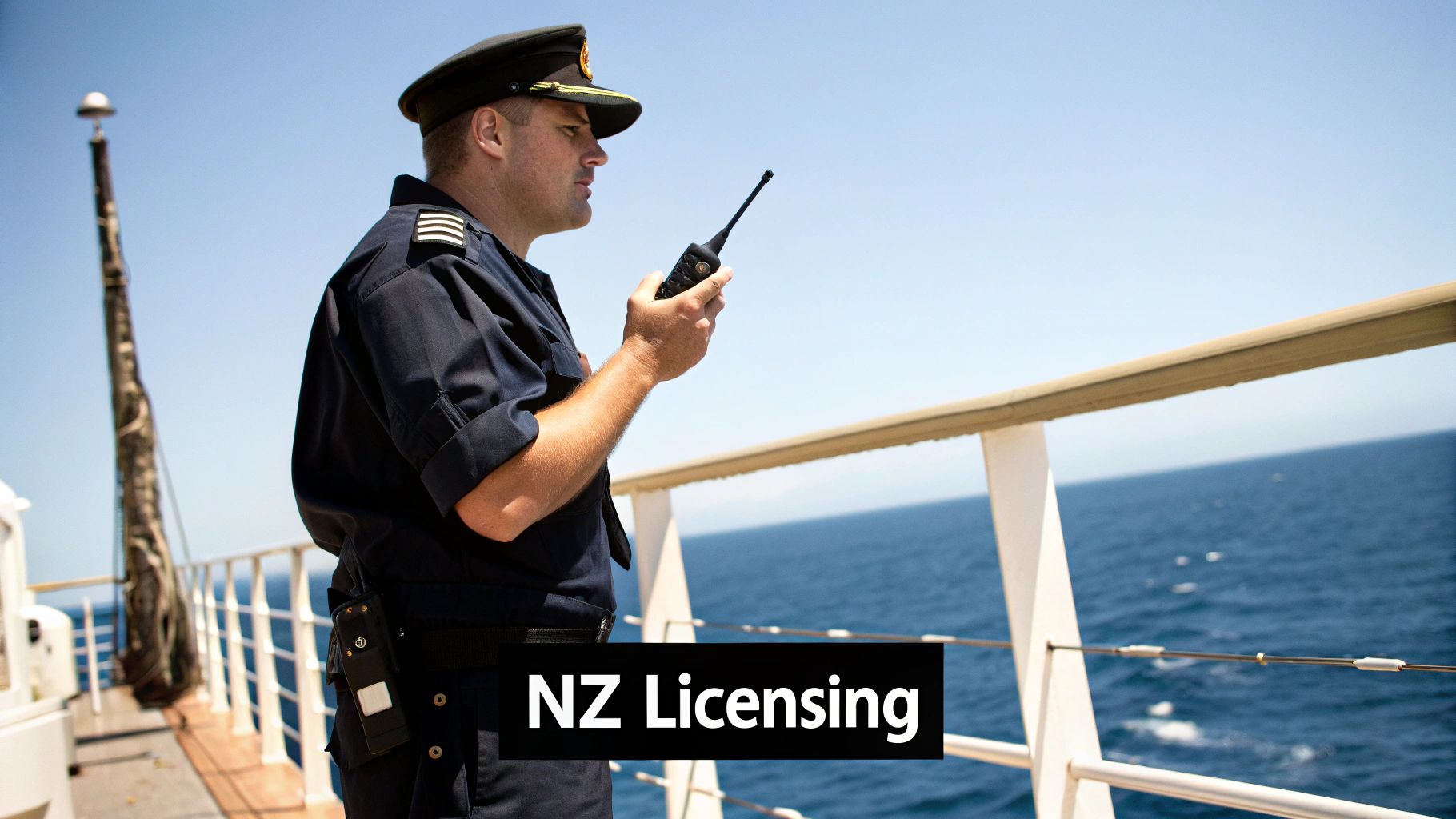
Jumping on a VHF marine radio in New Zealand isn't a free-for-all. It’s a serious responsibility, governed by clear rules designed to keep everyone out on the water safe. Think of it like getting your driver's licence—you need to know the rules of the road to avoid chaos, and on the water, you need to understand the rules of the airwaves.
The legal framework for a VHF marine radio in NZ has two key parts, and it’s critical to understand that they are separate requirements. Having one doesn't automatically cover the other.
The Two Pillars of VHF Radio Legality
To be fully compliant and legal, you generally need both a licence for your vessel and a certificate for yourself. It’s a straightforward system designed to make sure the gear is registered and the person using it knows what they're doing.
- Ship’s Radio Licence: This licence is for your boat. It registers your vessel and its radio equipment with Radio Spectrum Management (RSM) and gives you a unique call sign (like ZMW1234). This call sign becomes your boat's identity on the airwaves, used for all voice communications.
- Maritime VHF Radio Operator Certificate: This certificate is for you, the operator. It proves you have the knowledge to use the radio correctly, especially when things go wrong. You absolutely must hold this certificate to legally transmit on a VHF radio in New Zealand.
This isn’t some new bureaucratic hoop to jump through. The system has deep roots, with the government's role in radio communication dating back to the Wireless Telegraphy Act of 1903. This paved the way for the first coast stations from 1911, just a few years after Sir Joseph Ward sent the first-ever wireless message in New Zealand. You can dive into this rich history on the RSM website.
Getting Your Operator Certificate
Getting your Maritime VHF Radio Operator Certificate is a practical and incredibly valuable process. Organisations like Coastguard Boating Education are the go-to providers for the course and exam here in New Zealand.
The course is designed to be hands-on, teaching you essential skills that could genuinely save a life one day. You’ll learn things like:
- How to make critical distress calls like Mayday and Pan Pan.
- The correct radio procedures and on-air etiquette.
- Which channels to use for what purpose.
- The functions of modern radios, including the vital DSC feature.
Earning your operator certificate is about so much more than just ticking a legal box. It’s an investment in your own confidence. The training ensures that if you ever face a real emergency, you’ll be able to communicate clearly and effectively, without freezing up.
Demystifying the MMSI Number
As radio technology has moved forward, so have the requirements. If your VHF radio is equipped with Digital Selective Calling (DSC)—and most new ones available in New Zealand are—you'll also need a Maritime Mobile Service Identity (MMSI) number.
Think of the MMSI as your boat’s digital fingerprint. It's a unique nine-digit number programmed into your radio that links directly to your vessel's details. When you press that big red distress button on a DSC radio, it instantly sends an automated alert. This alert contains your MMSI and, if your radio is linked to a GPS, your precise location.
This gives search and rescue services immediate, accurate information, even if you don't have time to make a voice call. You get your MMSI when you apply for your Ship’s Radio Licence, neatly tying your call sign and MMSI together under one registration.
How the NZ VHF Radio Network Keeps You Connected
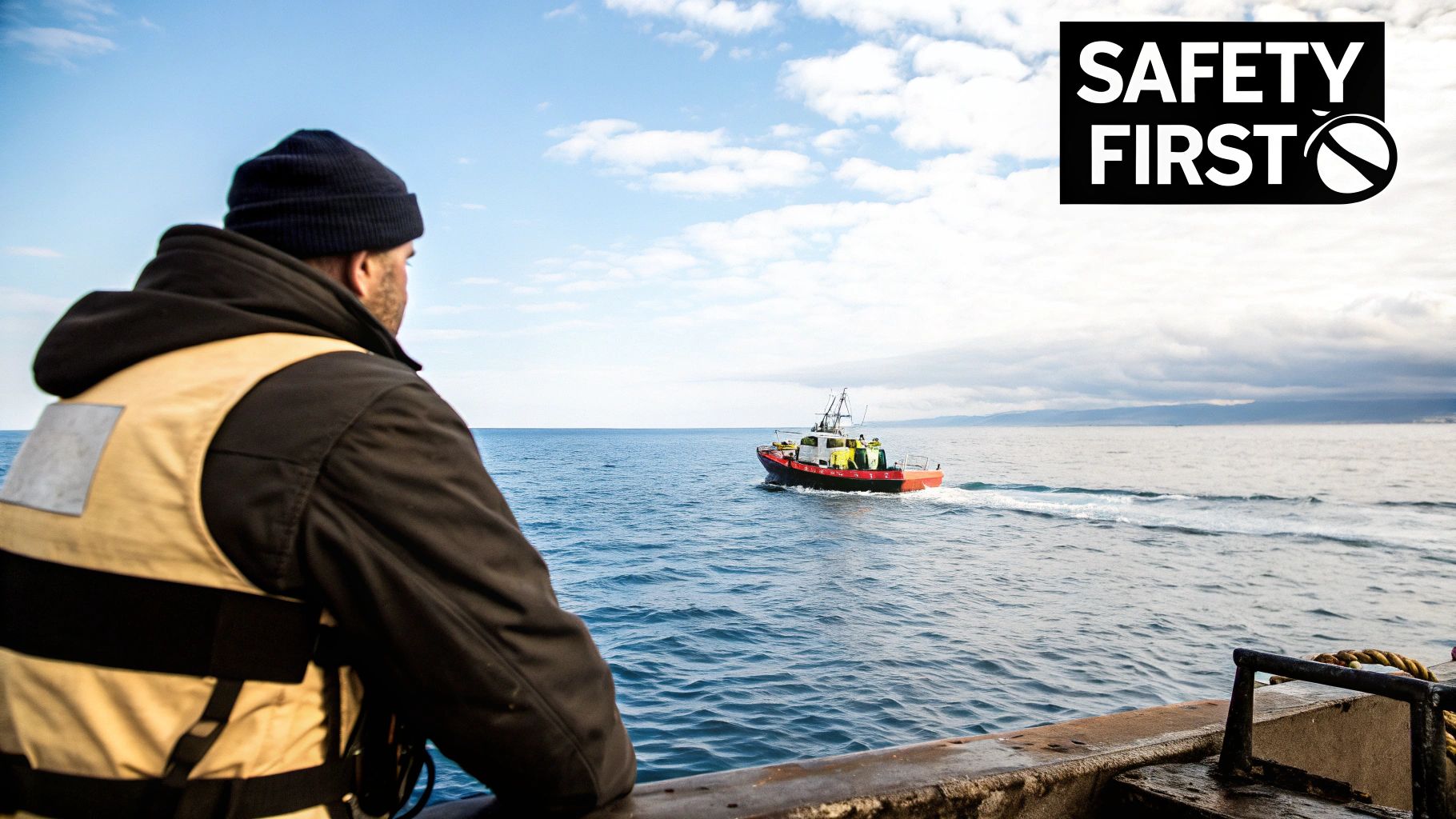
When you send a message over your VHF marine radio, it can feel a bit like magic—your voice just appears where it needs to go. But behind that seemingly simple transmission is a robust, carefully planned infrastructure that wraps a critical safety net around New Zealand's entire coastline. It’s not magic; it’s a powerful network designed to keep you connected when it matters most.
This entire system is managed by Maritime New Zealand, and it forms the backbone of all our maritime communications. It's the reason that whether you're logging a trip report, calling for help, or just tuning in for the latest weather forecast, there's a reliable system ready to handle your call.
The Maritime NZ Coastal Station Network
At the very core of New Zealand's VHF coverage is a strategically placed web of coastal stations. Think of it as an invisible highway for your radio signals, creating a blanket of reliable communication across our waters.
This network is a vital piece of our national safety puzzle, made up of 28 coastal stations that cover New Zealand's main coastal areas, plus two extra stations to look after the Chatham Islands. This setup ensures that distress calls, weather updates, and navigational warnings are broadcast and received efficiently. For a deeper dive into how this system keeps Kiwi boaties safe, you can check out the details on the Maritime New Zealand website.
These stations are your direct link to shore-based help and information. When you transmit, your signal gets picked up by the nearest station, which can then pass your message along or reply directly. It’s a system built for impressive reach and reliability, far beyond what any single boat radio could manage on its own.
Understanding VHF Range and Its Limitations
While the network is incredibly extensive, it's crucial to have realistic expectations about what it can do. VHF radio operates on a "line-of-sight" basis. The easiest way to picture this is to imagine a piece of string tied between your boat's antenna and the receiving station's antenna—if a big hill or a headland gets in the way, the signal is blocked. Simple as that.
Understanding the physical limits of your VHF radio is as important as knowing how to use it. Acknowledging these boundaries is a fundamental part of responsible voyage planning and staying safe on the water.
This line-of-sight reality has some very practical implications for anyone boating around New Zealand's rugged coastline.
- Typical Range: Out in open water with a clear path, you can generally count on a reliable communication range of 20 to 60 nautical miles. This distance is heavily influenced by your antenna height; the higher your antenna is mounted, the further your signal can "see" over the horizon.
- Terrain Shadowing: When you're navigating areas with steep cliffs or deep inlets, like you'd find in Fiordland or parts of the Marlborough Sounds, you can run into "terrain shadowing." This is where the land itself physically blocks your radio signal from reaching a coastal station, creating communication black spots.
Knowing about these limitations means you can plan your trip accordingly. For instance, before you head into a remote fiord, you might make a quick trip report, knowing your ability to communicate could be patchy until you’re back in open water.
Navigating the Channels Correctly
The VHF network is organised using specific channels for different purposes. This isn't just for tidiness—it’s essential for keeping communications orderly and making sure emergency lines stay clear for those who need them. Using the right channel is a core part of good radio etiquette.
To help you get it right, here’s a quick-reference table of the most important channels for boaties in New Zealand.
| Key NZ VHF Marine Radio Channels and Their Uses | ||
|---|---|---|
| Channel Number | Primary Use | Notes for NZ Boaters |
| 16 | Distress, Safety & Calling | The most important channel. Monitored 24/7 by Maritime Radio. Strictly for emergencies and making initial contact. |
| 6, 8, 77 | Ship-to-Ship (Intership) | General-use channels for routine conversations between vessels. Switch to one of these after calling on Ch. 16. |
| 67, 68, 69, 71 | Continuous Weather Broadcasts | Tune in to these channels for automated, round-the-clock weather forecasts from Maritime Radio. |
| 01, 02, 03, 04, 05, 60, 61, 62, 63, 64, 65 | Trip Reports & Ship-to-Shore | These are the working channels for Maritime Radio. Use them for logging trip reports or other non-distress calls to the coast. |
| 12, 13, 14, 72, 73 | Port Operations / Marinas | Used for communicating with harbourmasters, pilot boats, and marinas. Check local charts for the specific channel in your area. |
Getting familiar with these channels is a key part of being a responsible skipper.
The most critical channel of all is VHF Channel 16, the international frequency for distress, safety, and calling. It’s monitored 24/7 by Maritime Radio and is reserved strictly for emergencies. Using Channel 16 for a casual chat is the equivalent of calling 111 to order a pizza—it clogs up a vital lifeline.
When you need to make a routine call, make contact on Channel 16 first, then immediately agree to switch to a working or "ship-to-ship" channel to carry on your conversation. If you want a complete list and a deeper breakdown of the frequencies, you might find our guide to VHF marine radio frequencies useful.
Choosing the Right VHF Radio for Your Boat
Picking the perfect VHF radio for your boat can feel like a big decision, especially with all the different models and features out there. But it doesn't have to be complicated. Really, it all boils down to two main types of radios and a handful of must-have features.
Nailing this choice means your investment will keep you safe and connected, whether you're flicking a line in the Bay of Islands or cruising through the Marlborough Sounds.
Fixed-Mount vs Handheld Radios
Your first big decision is whether to get a fixed-mount unit or a portable handheld radio. Each has its own job to do, and the right one for you really depends on your boat and how you use it.
A fixed-mount radio is exactly what it sounds like—a permanent installation, usually right at the helm. These units are wired straight into your boat’s electrical system and connect to an external antenna that you’ll want to mount as high as possible for the best range.
On the other hand, a handheld radio is a tough, self-contained unit that looks a bit like a heavy-duty walkie-talkie. It runs on rechargeable batteries and has its own small antenna, making it ideal for kayaks, tenders, or as an essential backup in your ditch bag.
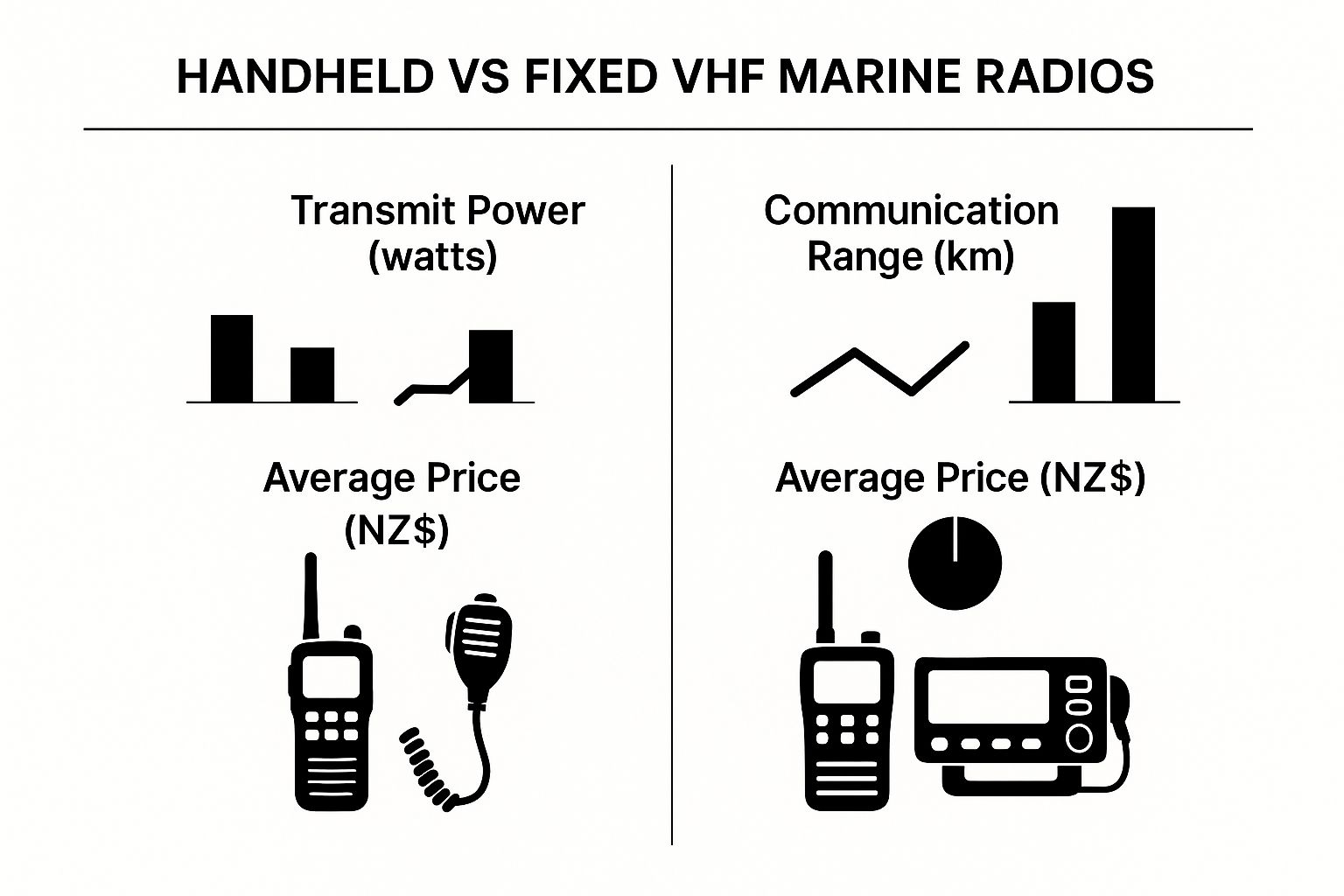
As you can see, the fixed-mount units pack a much bigger punch in power and range, while handhelds are all about grab-and-go convenience.
To make the decision even clearer, here’s a quick comparison of the key differences.
Fixed-Mount vs Handheld VHF Radio Comparison
| Feature | Fixed-Mount VHF | Handheld VHF |
|---|---|---|
| Power Output | 25 watts (maximum legal power) | 1 to 6 watts |
| Range | 15-25 nautical miles (or more, depending on antenna height) | 3-8 nautical miles (line-of-sight) |
| Power Source | Boat's 12V battery system | Rechargeable battery pack |
| Antenna | External, high-gain antenna mounted high on the vessel | Small, integrated antenna |
| Portability | Permanently installed at the helm | Fully portable, can be carried anywhere |
| Best For | Trailer boats, yachts, launches, and offshore vessels | Kayaks, dinghies, tenders, or as a backup radio |
| Key Advantage | Maximum power and range | Ultimate portability and backup safety |
Ultimately, many boaties in New Zealand end up with both: a reliable fixed-mount at the helm and a handheld in the ditch bag for that extra layer of safety.
Must-Have Features Explained Simply
Modern VHF radios are packed with technology, but you don't need to get lost in the details. A few features are absolutely critical for safety on the water here in New Zealand.
-
Digital Selective Calling (DSC): This is, without a doubt, the most important safety feature to come to VHF radio. A DSC-capable radio has a very obvious red "DISTRESS" button, usually under a protective flap. In an emergency, one push sends an automated digital alert on the dedicated Channel 70. This alert contains your boat's unique MMSI number and—if your radio is linked to a GPS—your exact location. It’s a one-touch Mayday that tells rescuers who you are and where you are, even if you can't get a voice call out.
-
Integrated GPS: A lot of new radios, both fixed and handheld, now have a GPS receiver built right in. This is a game-changer. It means the radio always knows its position for those crucial DSC alerts without needing to be wired into a separate chartplotter or GPS unit. It makes your DSC function much more powerful and completely foolproof.
-
IPX7/IPX8 Waterproof Rating: Let's face it, the marine environment is wet. An IPX7 rating means the radio can handle being submerged in 1 metre of water for 30 minutes. IPX8 is even tougher. For a handheld radio that could easily end up in the drink, a high waterproof rating isn't just nice to have—it's essential.
Top Brands and Models in New Zealand
When you’re buying a VHF marine radio in NZ, it pays to stick with the brands that have a proven track record for reliability and local support. Names like Icom, Uniden, and GME are trusted staples in the Kiwi marine scene for very good reason.
Here are a few common scenarios and the types of radios that fit them well:
- For the Kayaker or Tender: A compact, floating handheld like the Icom IC-M25 or Uniden MHS135UV is perfect. They’re fully waterproof, some even have a flashing light to help you find them in the water, and they give you that vital communication link for coastal trips.
- For the Small Trailer Boat: A workhorse fixed-mount unit like the GME GX700 or Icom IC-M330GE is a fantastic choice. You get the full 25 watts of power and the life-saving DSC feature with a built-in GPS, all without breaking the bank.
- For the Offshore Cruiser: If you're heading further afield, an advanced fixed-mount radio like the Icom IC-M510 is worth the investment. These often come with an integrated AIS receiver (so you can see other big vessels on your screen), have larger displays, and give you the option of adding a second microphone station elsewhere on the boat.
New Zealand's coastal VHF network is incredibly effective, providing reliable coverage up to 60 nautical miles offshore in good conditions, making your radio a powerful tool. If you want to dive deeper into the basics of VHF, our guide about VHF marine radio is a great place to start.
Proper Installation and Maintenance for Reliability
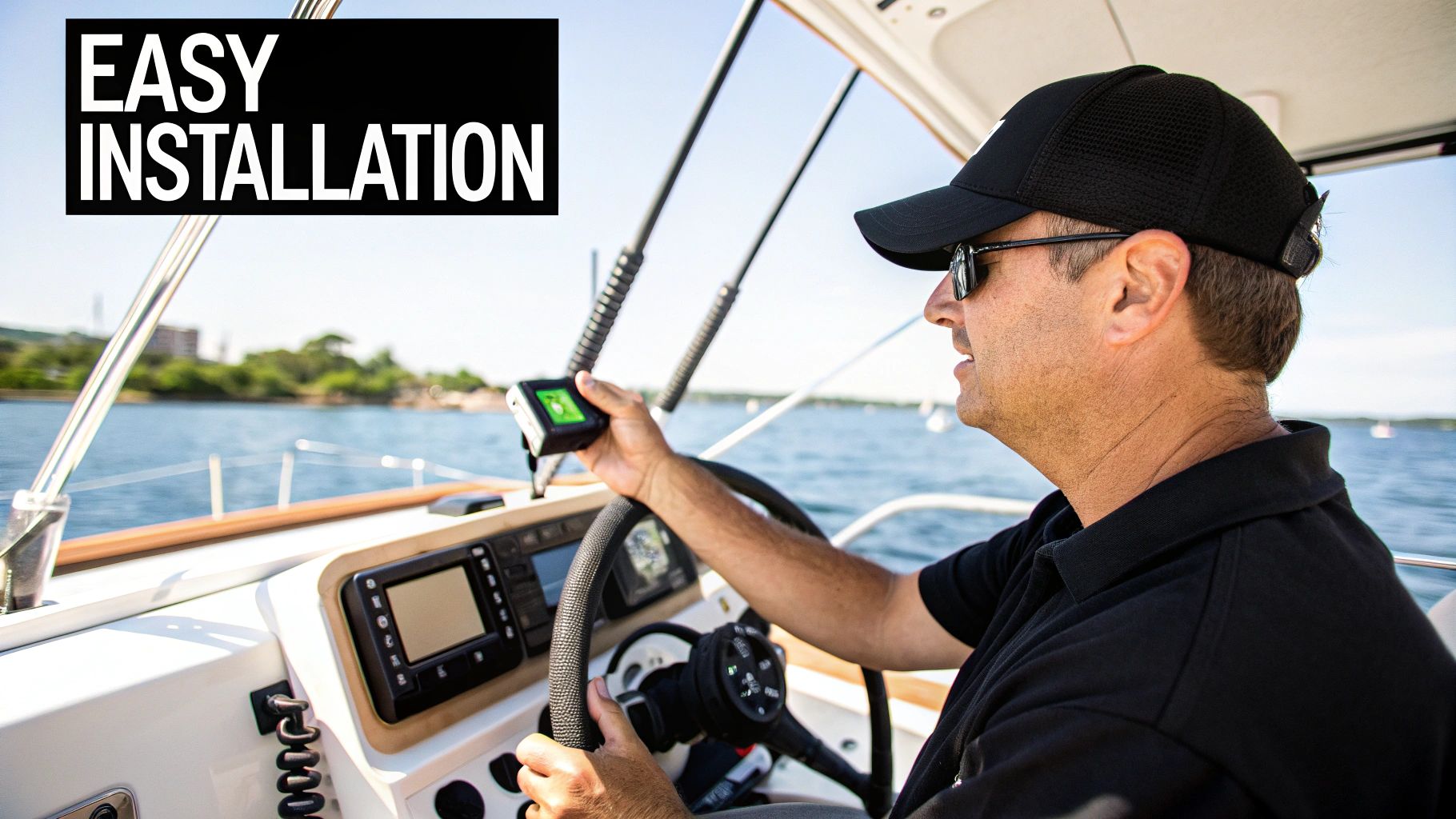
You can have the best VHF radio in the world, but it’s only as good as its installation. A shoddy wiring job or a neglected antenna can easily turn a powerful 25-watt radio into little more than a paperweight when you really need it. Getting flawless performance from your VHF marine radio in NZ comes down to two things: a solid initial setup and a simple, ongoing maintenance routine.
For a fixed-mount radio, the single most important part of your setup—the one that really dictates your communication range—is the antenna. Its placement and condition are everything. Think of it this way: if your radio is the lungs, the antenna is the voice. It doesn't matter how much air you've got if your voice is just a whisper.
Getting the installation right from day one gives you the peace of mind that your lifeline will actually work in an emergency.
The Unsung Hero: Your Fixed-Mount Antenna
To squeeze every bit of performance out of your radio, the golden rule is to mount your antenna as high as practically possible. VHF signals travel in a straight line, so a higher antenna can literally "see" further over the horizon, which dramatically increases your range. It also needs to be mounted perfectly vertically and well clear of any big metal objects that could mess with its signal.
The cable connecting the antenna to your radio unit is just as important. Always use high-quality, marine-grade coaxial cable (like RG8X or the thicker RG-213 for longer runs) and make sure every connection is screwed on tight and properly waterproofed. A dodgy connection here can cause a huge amount of signal loss before your transmission even leaves the boat.
Here are a few essential tips for installation:
- Power Connection: Run the power cable for your radio directly to the boat's battery or a dedicated busbar, and always include an in-line fuse. Try to avoid wiring it into a crowded accessory panel, as electrical "noise" from other gadgets can interfere with your radio.
- GPS Connection: If your radio has DSC but doesn't have its own built-in GPS, you must connect it to a GPS source like your chartplotter. This is critical because it's what lets your radio broadcast your exact coordinates during a Mayday call. Double-check the NMEA 0183 or NMEA 2000 wiring instructions to get this right.
Proper installation isn't just about ticking a box; it's a fundamental part of boat safety. The time you spend ensuring clean power, solid connections, and optimal antenna placement is a direct investment in your ability to call for help.
A Simple Maintenance Checklist for All Radios
Once it’s all set up, your radio just needs a little bit of TLC to keep it in top working order. Doing these quick checks regularly can prevent a failure when you're out on the water.
This simple list works for both fixed-mount and handheld radios and is a great addition to your pre-departure routine.
Monthly Maintenance Checklist:
- Check All Connections: On fixed-mount units, make sure the antenna and power plugs at the back of the radio are snug. Look for any green or white powder—a dead giveaway for corrosion—and clean it off. A quick spray with a corrosion inhibitor does wonders.
- Inspect Visible Cabling: Have a look at the antenna cable for any cracks, chafe, or other damage. Secure any loose bits so they can't get snagged or worn through.
- Test Battery Life (Handhelds): Always fully charge your handheld before heading out. If you start to notice the battery isn't lasting as long as it used to, it's time to order a replacement. Don't wait for it to fail completely.
- Perform a Radio Check: This is the most important step. Never use Channel 16 for a radio check. Instead, flick over to a local Coastguard or Maritime Radio working channel. A simple call like, "Maritime Radio, this is [Your Boat Name], radio check, over," is all it takes. They'll reply and tell you how you're sounding, giving you total confidence in your gear.
Common Questions About VHF Marine Radio in NZ
Even when you've got all the right gear and think you know the ropes, a few practical questions always pop up. It’s completely normal. Getting your head around these common queries is what builds real confidence on the water, making sure you can use your radio correctly and safely every time you head out. Let's tackle the "what ifs" and "how-tos" that every Kiwi boatie wonders about.
Do I Really Need a VHF with a Mobile and EPIRB?
Yes, absolutely. It's a common but dangerous mistake to think these devices are interchangeable. They aren’t. Each one plays a unique, critical role in your overall safety system, and they simply don't replace each other.
Your mobile phone's coverage is notoriously patchy once you’re even a short distance from shore—you just can't count on it. An EPIRB (Emergency Position Indicating Radio Beacon) is your last-ditch, one-way distress signal. You set it off, it pings a satellite, but that's it. You can't talk to anyone or get any information back.
A VHF radio is your primary tool for two-way communication. It lets you talk directly with rescuers to explain exactly what's wrong, hear urgent weather updates as they're broadcast, and chat with other boats nearby who might be able to help long before a formal rescue mission gets to you.
Think of it like a layered safety net. Your VHF is for active, real-time communication and preventing things from getting worse. Your EPIRB is the final, passive alert you use when all other options are gone.
What Is the Difference Between a Call Sign and an MMSI Number?
This one trips a lot of people up, but the difference is actually pretty simple—and it’s vital for using a modern radio properly. Both are unique identifiers for your boat, but they’re used for completely different things.
A Call Sign (like 'ZMW1234') is your boat's name on the airwaves, a bit like a car's number plate. You say it out loud at the beginning and end of your voice calls so everyone knows who’s talking.
An MMSI (Maritime Mobile Service Identity) is a unique nine-digit number that gets programmed into a DSC-capable radio. Its main job is to power that little red distress button. When you press it, your radio sends a digital alert on the dedicated Channel 70 that includes your MMSI and GPS location, instantly telling rescuers who and where you are without a single word being spoken.
How Do I Perform a Proper Radio Check in New Zealand?
Doing a radio check is a crucial part of your pre-trip checklist, but getting it wrong can cause real headaches for everyone. The number one rule is to never, ever use Channel 16 for a radio check. That channel has to be kept clear for genuine distress calls, period.
To do it the right way, just follow these simple steps:
- Pick a Working Channel: Switch over to a designated ship-to-ship or local Coastguard working channel. Channels like 63, 64, or 65 are usually good options for this.
- Listen First: Before you key the mic, just listen for a moment. Make sure the channel is quiet and you're not about to talk over someone else's conversation.
- Make the Call: State clearly who you're calling (three times) and who you are (once). For example: "Maritime Radio, Maritime Radio, Maritime Radio, this is vessel Starlight, call sign ZMW1234, over."
- Ask for the Check: Once they reply, keep it brief: "Request a radio check, over."
- Get Confirmation: They'll come back to you with a report on your signal, like "Loud and clear." That's it—you now know your radio is transmitting and receiving just fine.
If you’re new to this, there’s a lot to learn, but you can find a great guide on how to use a marine VHF radio that covers all the basics.
Can I Use an American VHF Radio in New Zealand?
Honestly, using a radio you bought overseas—especially from the US—is asking for trouble and generally not a good idea. To be legal and work properly here, your radio must be type-approved by Radio Spectrum Management (RSM) and programmed with the correct international channel set for New Zealand.
The problem is that some US-market radios use different channels. Their "weather" channels, for instance, can overlap with standard marine channels we use in NZ. This can cause interference or, even worse, mean you can't communicate on the right frequency when you really need to.
To be sure your VHF marine radio in NZ is compliant and will work when it counts, always buy from a trusted local supplier. They'll make sure the model meets all the RSM standards and is programmed perfectly for our waters. For more answers to common questions about communication gear, check out our comprehensive FAQ page.


